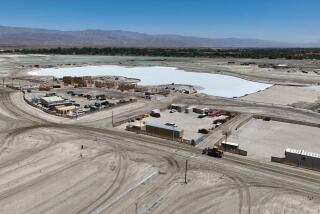San Juan May Annex Ranchland to Keep a Ridgeline Unbuilt
The city of San Juan Capistrano is considering annexing a stretch of rolling foothills and ranchland to protect the city’s “small-town feel” and spare a prominent ridgeline from possible development.
The land, east of the city limits along Ortega Highway, is owned by Rancho Mission Viejo and includes a riding club and horse stables. In all, the property sprawls over 25,000 acres but the city is interested in annexing only a small part.
The City Council this week voted to hire a team of consultants to study the area and make recommendations for annexation boundaries, which could stretch beyond Antonio Parkway, said Tom Tomlinson, the city’s planning director.
“The area that we’re talking about is visually connected to the community of San Juan Capistrano,” Tomlinson said.
“So we’d be very interested in shaping the development of that area.”
City officials also want to have a say in preserving some of the land--primarily the ridgelines next to Antonio Parkway and La Pata Avenue, Councilman David M. Swerdlin said.
“The city wants to ensure that our eastern entrance to San Juan Capistrano maintains a specific ambience, and that it has a small-town feel,” Swerdlin said.
That area is currently home to the Oaks Blenheim/Rancho Mission Viejo Riding Club, the Rancho Mission Viejo Land Conservancy and privately leased stables, among other uses, said Diane Gaynor, a Rancho Mission Viejo spokeswoman.
The city’s interest was sparked by a letter that the principal ranch owner--the families of Richard O’Neill and Anthony Moiso--sent to the county in November, saying they were studying what to do with their remaining 25,000 acres of ranchland.
Since 1950, the families have developed 25,000 acres into the communities of Mission Viejo, Rancho Santa Margarita, Las Flores and Ladera Ranch, with 9,255 acres set aside as parks and open space.
The families plan to continue using the land for ranching and agricultural operations, but some of the property must be developed, Gaynor said.
Ranch owners are conducting environmental studies in conjunction with federal and state wildlife agencies to determine which areas should be protected from development.
“The cost to maintain the property, to continue ranching and continue farming are astronomical,” Gaynor said.
“And in order to preserve the families’ ranching heritage and open space and continue the farming and other operations that have been going on there for a long, long time, the reality is that there will be managed growth on the ranch.”
More to Read
Sign up for Essential California
The most important California stories and recommendations in your inbox every morning.
You may occasionally receive promotional content from the Los Angeles Times.










